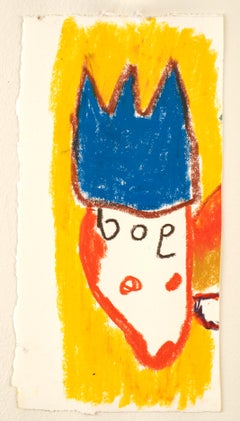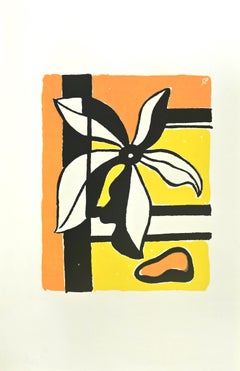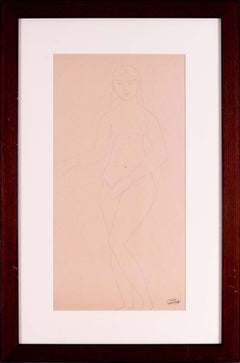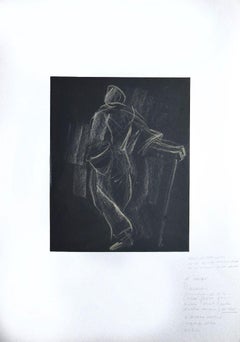Fauvist Art
Style: Fauvist
Color: White
Early 20th Century French Fauvist drawing by Andre Derain of a Saint
By André Derain
Located in Petworth, West Sussex
Andre Derain (French, 1880 – 1954)
Saint
Black crayon
Signed with atelier stamp (lower right)
15.1/8 x 9.1/2 in. (38.3 x 24 cm.)
André Derain (10 June 1880 – 8 September 1954) was a...
Category
20th Century Fauvist Art
Materials
Crayon, Paper
Dog
Located in New York, NY
Wax pastel on paper.
Category
2010s Fauvist Art
Materials
Wax Crayon
Fleur sur un Fond Jaune et Orange - Screen Print after F. Leger - 1950s
Located in Roma, IT
Fleur sur un fond Jaune et Orange is a contemporary artwork realized by Jean Bruller after a gouache by Fernand Léger.
Screen print on Arches wove paper.
Unsigned, from a portfolio...
Category
Mid-20th Century Fauvist Art
Materials
Screen
Study of a Dancer and a Lady by Ludovic-Rodo Pissarro - Watercolour
Located in London, GB
*UK BUYERS WILL PAY AN ADDITIONAL 20% VAT ON TOP OF THE ABOVE PRICE
Study of a Dancer and a Lady by Ludovic-Rodo Pissarro (1878-1952)
Watercolour and pencil on paper
21 x 15.7 cm (8...
Category
Early 1900s Fauvist Art
Materials
Paper, Watercolor, Pencil
Early 20th Century French Fauvist drawing by Andre Derain of a lady in a dress
By André Derain
Located in Petworth, West Sussex
Andre Derain (French, 1880 – 1954)
Lady in a dress
Pencil on paper
Signed with atelier stamp (lower right)
14.5/8 x 9.3/8 in. (37 x 23 cm.)
André Derain (10 June 1880 – 8 September ...
Category
Early 20th Century Fauvist Art
Materials
Pencil, Paper
Early 20th Century French Fauvist drawing of a nude by Andre Derain
By André Derain
Located in Petworth, West Sussex
Andre Derain (French, 1880 – 1954)
A nude looking right
Pencil on paper
Signed with atelier stamp (lower right)
16.1/4 x 8.1/4 in. (41.1 x 21 cm.)
André Derain (10 June 1880 – 8 Sep...
Category
Early 20th Century Fauvist Art
Materials
Pencil, Paper
The Prisoner
Located in Mount Vernon, NY
Etching, signed in the plate.
Category
1660s Fauvist Art
Materials
Etching
Related Items
Ambassadeurs Aristide Bruant in his cabaret by Henri de Toulouse-Lautrec
Located in New York, NY
This lithographic poster illustrates Aristide Bruant who was a famous performer and cabaret owner in Paris at the turn of the 20th century. Lautrec, seizing on Bruant's trademark cos...
Category
Late 19th Century Fauvist Art
Materials
Lithograph
A Figure from Behind - Original Pastel on Paper by Helen Vogt - 1935
By Helen Vogt
Located in Roma, IT
A Figure from Behind is an original modern artwork realized in 1935 by Hélène Vogt (1902 - 1994).
Original white pastel on black paper.
Passepartout is included (cm 50 x 35). The ...
Category
1930s Fauvist Art
Materials
Pencil, Pastel
H 9.85 in W 7.88 in D 0.08 in
Series - Les Lavandières by Lélia Pissarro - Screenprint
Located in London, GB
SOLD UNFRAMED
Series - Les Lavandières by Lélia Pissarro (B. 1963)
Serigraph
38 x 48 cm (15 x 18 ⁷/₈ inches)
Signed and numbered
Printed in an edition of 300
Artist's Biography:
B...
Category
21st Century and Contemporary Fauvist Art
Materials
Screen
Temple Official
Located in London, GB
'Temple Official', pencil and watercolour on paper by Robert Taylor Pritchett (1882). This is the artist's portrait of a financial official in a Cantonese temple in Guangzhou, China in the latter half of the 19th century. His garment is typical of that of a senior civil servant of the Chinese government. Clothes were designed to indicate rank and status, becoming so distinct that the wearer’s position could be ascertained at a glance. During his second career as an artist, Pritchett traveled widely in the Pacific region in the 1880s. This artwork has been professionally restored and cleaned to preserve it for decades to come and therefore in good overall condition. It has also been newly framed and glazed. The artist has written 'The Treasurer & Temple' and '5 Geni Temple, Canton Jan. 22 1882' on the lower left and right hands of the artwork. Upon request a video of the work may be provided.
About the Artist: Robert Taylor Pritchett (1823 - 1907), a gun maker and artist, was the son of Richard Ellis...
Category
1880s Fauvist Art
Materials
Paper, Watercolor, Pencil
Judy Garland Hollywood Film 1963 Costume Design Mid 20th Century Gay Icon Oscars
Located in New York, NY
Judy Garland Hollywood Film 1963 Costume Design Mid 20th Century Gay Icon Oscars
EDITH HEAD (1897-1981) Original costume design for the red dress worn by J...
Category
1960s Fauvist Art
Materials
Pencil, Watercolor, Paper
Series - Monet's House by Lélia Pissarro - Screenprint
Located in London, GB
Series - Monet's House by Lélia Pissarro (B. 1963)
Serigraph
38 x 48 cm (15 x 18 ⁷/₈ inches)
Signed and numbered
Printed in an edition of 300
Artist's Biography:
Born in Paris in 19...
Category
21st Century and Contemporary Fauvist Art
Materials
Screen
Pierre Bonnard ltd edition Lithograph Printed at Mourlot Paris 1958 Chicken, Egg
Located in Surfside, FL
This is from a limited edition portfolio of original lithographs print Fernand Mourlot in Paris in 1958 from work done in collaboration with Bonnard which began in 1928.
This is from the rare first edition, No. VII of 20 unbound sets, specially printed for Hans P. Kraus, with Henry de Montherlant inscription to him signed and dated March 3, 1960
These are not individually hand signed or numbered.
On BFK Rives French velin art paper
Pierre Bonnard (1867 – 1947) was a French painter, illustrator and printmaker, known especially for the stylized decorative qualities of his paintings and his bold use of color. A founding member of the Post-Impressionist group of avant-garde painters Les Nabis, (the Naive artists) his early work was strongly influenced by the work of Paul Gauguin, as well as the prints of Hokusai and other Japanese artists. Bonnard was a leading figure in the transition from Impressionism to Modernism. He painted landscapes, urban scenes, portraits and intimate domestic scenes, where the backgrounds, colors and painting style usually took precedence over the subject.
Pierre Bonnard was born in Fontenay-aux-Roses, Hauts-de-Seine on 3 October 1867. His mother, Élisabeth Metzdorff, was from Alsace. His father, Eugène Bonnard, was from the Dauphiné, and was a senior official in the French Ministry of War. He had a brother, Charles, and a sister, Andrée, who in 1890 married the composer Claude Terrasse.
He received his education in the Lycée Louis-le-Grand and Lycée Charlemagne in Vanves. He showed a talent for drawing and water colors, as well as caricatures. He painted frequently in the gardens of his parent's country home at Grand-Lemps near the Cote Saint-André in the Dauphiné. He also showed a strong interest in literature. He received his baccalaureate in the classics, and, to satisfy his father, between 1886 and 1887 earned his license in law, and began practicing as a lawyer beginning in 1888. While he was studying law, he also attended art classes at the Académie Julian in Paris. At the Académie Julien he met his future friends and fellow artists, Paul Sérusier, Maurice Denis, Gabriel Ibels and Paul Ranson. In 1888 Bonnard was accepted by the École des Beaux-Arts, where he met Édouard Vuillard and Ker Xavier Roussel. He also sold his first commercial work of art, a design for poster for France-Champagne, which helped him convince his family that he could make a living as an artist. He set up his first studio at on rue Lechapelais and began his career as an artist.
From 1893 until her death, Bonnard lived with Marthe de Méligny (1869–1942), and she was the model for many of his paintings, including many nude works. Her birth name was Maria Boursin, but she had changed it before she met Bonnard. They married in 1925. In the years before their marriage, Bonnard had love affairs with two other women, who also served as models for some of his paintings, Renée Monchaty (the partner of the American painter Harry Lachmann) and Lucienne Dupuy de Frenelle, the wife of a doctor; it has been suggested that Bonnard may have been the father of Lucienne's second son. Renée Monchaty committed suicide shortly after Bonnard and de Méligny married.
In 1891 he met Toulouse-Lautrec and in December 1891 showed his work at the annual exhibition of the Société des Artistes Indépendants. In the same year Bonnard also began an association with La Revue Blanche, for which he and Edouard Vuillard designed frontispiece In March 1891, his work was displayed with the work of the other Nabis at the Le Barc de Boutteville. The style of Japanese graphic arts became an important influence on Bonnard. In 1893 a major exposition of works of Utamaro and Hiroshige was held at the Durand-Rouel Gallery, and the Japanese influence, particularly the use of multiple points of view, and the use of bold geometric patterns in clothing, such as checkered blouses, began to appear in his work. Because of his passion for Japanese art, his nickname among the Nabis became Le Nabi le trés japonard. He devoted an increasing amount of attention to decorative art, designing furniture, fabrics, fans and other objects. He continued to design posters for France-Champagne, which gained him an audience outside the art world. In 1892 he began to produce lithographs, and painted two of his early notable works, Le Corsage a carreaux and La Partie de croquet. He also made a series of illustrations for the music books of his brother-in-law, Claude Terrasse. In 1895 he became an early participant of the movement of Art Nouveau, designing a stained glass window, called Maternity, for Tiffany. In 1895 he had his first individual exposition of paintings, posters and lithographs at the Durand-Ruel Gallery. He also illustrated a novel, Marie, by Peter Nansen, published in series by in La Revue Blanche. The following year he participated in a group exposition of Nabis at the Ambroise Vollard Gallery. In 1899, he took part in another major exposition of works of the Nabis.
Throughout the early 20th century, as artistic styles appeared and disappeared with almost dizzying speed, Bonnard kept refining and revising his personal style, and exploring new subjects and media, but keeping the distinct characteristics of his work. Working in his studio at 65 rue de Douai in Paris, he presented paintings at the Salon des Independents in 1900, and also made 109 lithographs for Parallèment, a book of poems by Verlaine. He also took part in an exhibition with the other Nabis at the Bernheim Jeune gallery. He presented nine paintings at the Salon des Independents in 1901. In 1905 he produced a series of nudes and of portraits, and in 1906 had a personal exposition at the Bernheim-Jeune Gallery. In 1908 he illustrated a book of poetry by Octave Mirbeau, and made his first long stay in the South of France, at the home of the painter Manguin in Saint-Tropez. in 1909, and in 1911 began a series of decorative panels, called Méditerranée, for the Russian art patron Ivan Morozov.
During the years of the First World War, Bonnard concentrated on nudes and portraits, and in 1916 completed a series of large compositions, including La Pastorale, Méditterranée, La Paradis Terreste and Paysage de Ville. His reputation in the French art establishment was secure; in 1918 he was selected, along with Renoir, as an honorary President of the Association of Young French Artists. In the 1920s, he produced illustrations for a book by Andre Gide (1924) and another by Claude Anet (1923). He showed works at the Autumn Salon in 1923, and in 1924 was honored with a retrospective of sixty-eight of his works at the Galerie Druet. In 1925 he purchased a villa in Cannes.
In 1938 his works and Vuillard were featured at an exposition at the Art Institute of Chicago. The outbreak of World War II in September 1939, forced Bonnard to depart Paris for the south of France, where he remained until the end of the war. Under the German occupation, he refused to paint an official portrait of the French collaborationist leader, Marechal Petain, but accepted a commission to paint a religious painting of Saint Francis de Sales, with the face of his friend Vuillard, who had died two years earlier. He finished his last painting, The Almond Tree in Blossom, a week before his death in his cottage on La Route de Serra Capoue near Le Cannet, on the French Riviera, in 1947. The Museum of Modern Art in New York City organized a posthumous retrospective of Bonnard's work in 1948, although originally it was meant to be a celebration of the artist's 80th birthday.
Bonnard particularly used the model of Japanese art in a series...
Category
20th Century Fauvist Art
Materials
Lithograph
Composition I
Located in Miami, FL
Screenprint on Lanaquarelle watercolor paper. Hand signed, numbered from the edition of 50 and dated in pencil. Published and printed by Gemini G.E.L., Los Angeles, with their blind...
Category
1990s Fauvist Art
Materials
Screen
'Cap Ferrat', Academy of Fine Arts of Rouen, Mandelieu-la-Napoule, Benezit, Oil
Located in Santa Cruz, CA
Signed lower right, 'Picot' for Jean-Claude Picot (French, born 1933), and painted circa 1985; additionally titled, verso, 'La Route Vers St Jean Cap Ferr'...
Category
1980s Fauvist Art
Materials
Oil, Canvas
H 10 in W 11.75 in D 0.75 in
"Wolfbat Leopard Snake" 6 Color enamel silkscreen
Located in Philadelphia, PA
"Wolfbat Leopard Snake" is a 6 color enamel ink silkscreen print measuring 29in x 21.5in, and is part of an edition of 25. The ink splatters in the background are part of the design...
Category
21st Century and Contemporary Fauvist Art
Materials
Enamel
Mid-Century Portrait of an Elegant Woman (unfinished)
Located in Soquel, CA
Portrait of an elegant woman by Joseph Yeager (American, 20th Century). This piece is unsigned, but was acquired with a collection of Yeager work directly from the estate. This piece...
Category
1960s Fauvist Art
Materials
Paper, Watercolor, Pencil
H 30 in W 22 in D 0.03 in
Lierre en Fleur
Located in Washington, DC
Artist: Henri Matisse (after)
Title: Lierre en Fleur
Portfolio: The Last Works of Henri Matisse
Medium: Lithograph
Date: 1958
Edition: 2000
Frame Size: 17" x 17"
Sheet Size: 14" x 10...
Category
1950s Fauvist Art
Materials
Lithograph
Fauvist art for sale on 1stDibs.
Find a wide variety of authentic Fauvist art available for sale on 1stDibs. Works in this style were very popular during the 21st Century and Contemporary, but contemporary artists have continued to produce works inspired by this movement. If you’re looking to add art created in this style to introduce contrast in an otherwise neutral space in your home, the works available on 1stDibs include elements of blue, orange, purple, green and other colors. Many Pop art paintings were created by popular artists on 1stDibs, including Charles Cobelle, (after) André Derain, Evelyne Ballestra, and (after) Pierre Bonnard. Frequently made by artists working with Paint, and Oil Paint and other materials, all of these pieces for sale are unique and have attracted attention over the years. Not every interior allows for large Fauvist art, so small editions measuring 3.94 inches across are also available. Prices for art made by famous or emerging artists can differ depending on medium, time period and other attributes. On 1stDibs, the price for these items starts at $1 and tops out at $2,835,000, while the average work sells for $1,532.
Recently Viewed
View AllMore Ways To Browse
Wall Fresco
19th Century Spanish Paintings
Greek Woman
Oil Painting Man 19th
Native American Gold
Cut Paper Wall Art
Antique Painting Auction
Antique Painting Auctions
Lady Just
Gold Leaf Painting Japan
Japanese Painting Gold Leaf
Sea Life Gold
Canvas Midcentury Print
Russian Vintage Fashion
Costa Vintage
Coat Mans
Head Of Man Sculpture
Sculpture 1942







